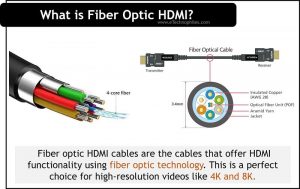Last updated on April 5th, 2024 at 12:00 pm
HDMI is used for transmitting high-resolution signals with excellent video and audio experience. With time, this technology has undergone several upgrades. The fiber optic HDMI is the latest update of HDMI with better features. In this article, we will discuss fiber optic HDMI cables in detail.
Table of Contents
What is a fiber optic HDMI cable?

To put it simply, fiber optic HDMI cables are the cables that offer HDMI functionality using fiber optic technology. This is a perfect choice for high-resolution videos like 4K and 8K.
Fiber optic HDMI cables are also called HDMI AOC, or Active Optical Cables. These cables are the updated version of the HDMI 2.0 standard. This HDMI technology is the finest solution for long-distance HDMI connections, where regular HDMI cables fail.
The fiber optic HDMI cable is capable of supporting 32 uncompressed audio channels so that it can transmit signals at about 18Gbps speed up to 50 meters in 4K resolution at a frequency of 60Hz.
Fiber optic HDMI cable v/s regular HDMI cable

Fiber optic cables can transmit signals over a long distance with better signal quality as compared to regular HDMI cables. The table compares the essential features of fiber optic HDMI cables with regular HDMI cables.
| Feature | Fiber Optic HDMI Cable | Regular HDMI Cable |
| Year of Launch | Around 2014 | 2002 |
| Material | Glass | Copper |
| Signal Transmitted | Light | Electricity |
| Maximum Cable Length | 300 meters | 15 meters |
| Bandwidth | 18Gbps | 18Gbps |
| Resolution | 8K at 60 Hz | 4K at 60 Hz |
| Best Application | Long-distance | Short-distance |
The significance of Fiber Optic HDMI cables
HDMI cables are ideal for connecting devices over short distances (up to 15 meters). But as the distance between the input source and output device increases, the signals face distortion. The signals lose their quality even if the repeaters are used to boost the signals. Hence in long-distance transmission, fiber optic HDMI cables are used.
The greatest advantage of fiber optic HDMI cables is that they can connect devices over a long distance which is up to 300 meters! This connectivity is offered by maintaining the same audio and video quality. And they do not require an additional power supply or repeaters to transmit the signals.
Why are they so efficient?
Copper cables use electricity to transmit signals while optical fibers use light. The signals in fiber optics travel with a much greater speed and provide much better quality than any copper cable equivalent.
How do fiber optic HDMI cables work?
The fiber optic HDMI cables use light or lasers to transmit data. The data is transferred as light pulses through fine strands of glass filaments. Since these are thin strands, they can transmit large amounts of signals. Converters are used at each end to convert the light into signals and vice versa.
Advantages
Fiber optic HDMI cables are highly utilized for making HDMI connections due to the reasons mentioned below.
Excellent performance even in very long distances
The key advantage of fiber optic HDMI cables is their capability to carry signals over a longer distance. The transmission of the signals by a regular HDMI starts to attenuate from 7.5 meters, whereas fiber optic HDMI cables can transmit 8K signals at 60Hz up to 15 meters without any delay or signal loss.
Hence they are highly utilized for long-distance applications like public security high-definition monitoring systems, industrial automation systems, high-definition video conference setups in offices, large-scale medical imaging systems, etc.
No EMI/RFI interference
While transmitting signals through a copper wire, signal interference due to electromagnetic and radiofrequency (EMI/RFI) takes place. This results in poor-quality audio and video signals. Since fiber optic HDMI cables transmit signals as light pulses, they are not affected by EMI/RFI.
Versatility
The connectors of fiber optic HDMI cables are compatible with large as well as small devices. The regular-sized connector consists of a detachable micro HDMI connector. It can be used to connect small devices like mobile phones and tablets. Hence it looks like a two-in-one connector (shown in the figure below).

Limitations of fiber optic HDMI cable
Fragility
The major drawback of fiber optic HDMI cables is their fragility. They are made of thin glass cores, that break easily. Hence these cables should not be twisted too far or left casually in a room.
One directional characteristic
Like regular HDMI cables, fiber optic HDMI cables are not duplex. The signal will not travel back and forth through the same cable. The source and display will be labeled separately and will not work if connected in reverse.
Cost
Cost is another serious concern regarding the fiber optic HDMI cables. When compared to regular HDMI cables, they are more expensive.
Conclusion
Fiber optic HDMI cables are used to transmit high-resolution signals over long distances. But if you are looking for a short-range connection, these cables may not be necessary to use. Because they are more expensive than regular HDMI but exhibit almost similar experiences. If cost is not an issue, both cables will suit well for your applications.

